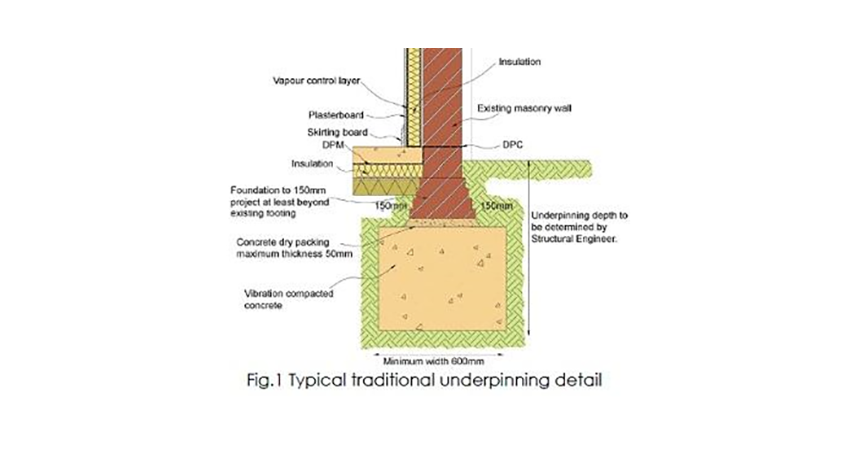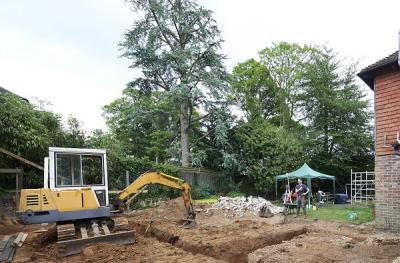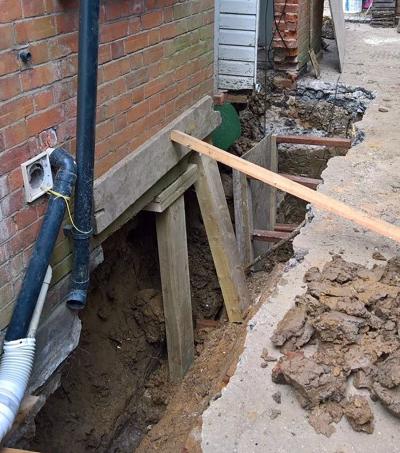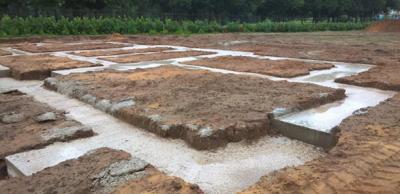Underpinning of existing foundations
Did you know that underpinning of foundations is notifiable work under the Building Regulations? You must make an application to the building control authority in all cases, without exception.
If the underpinning works are to be carried out adjacent or in close proximity to another existing building, you need to ensure your client complies with the requirements of the Party Wall etc Act 1996 by advising them to enter into a party wall agreement with the adjoining owner.
Where a building has been damaged by foundation movement and has required underpinning, there may also be a need to carry out structural repairs or strengthening work to the superstructure. Such works should be designed and specified by a competent structural engineer or a specialist structural repair company.
Mass concrete underpinning
The most common method is traditional mass concrete underpinning - a simple technique that involves excavating a segment of ground below the existing building foundation in controlled stages, to a depth where suitable bearing strata exists.
The excavation is then filled with concrete and allowed to cure before the next 'pin' is excavated. To transfer the building load safely to the new pin, a dry sand cement packing mortar is rammed in between the new and old foundation. Each ‘pin’ is typically connected with multiple reinforcement bars, which are driven into the sides of the excavations prior to pouring the concrete.
This method is suitable for shallow depth underpinning. Work can be carried out from one side of the wall and in areas of difficult and restricted access. It is suitable for heavy foundation loads and massive structures and for the formation of new cellars and basements beneath existing buildings.
Found this interesting? Have a look through our other 'How to get it right' articles
Points to remember
- The mass concrete technique cannot be adopted as a solution for all foundation failures. Other techniques will be required to overcome difficulties with groundwater, lose ground or fill.
- Ensure that the decision to use traditional mass concrete underpinning has been made by a competent person such as an experienced structural engineer.
- Where foundation movement has been caused by ground heave, (such as moisture recovery of clay soils following removal or decay of a tree) the underpinning scheme should incorporate appropriate anti-heave protection.
- Underpinning piles may require special design consideration and incorporate reinforcement over their entire length.
- Underpinning works are required to comply with the Construction (Design and Management) Regulations (CDM) 2015. If you are having work done on your own home, and it is not in connection with a business, you will be a ‘domestic client’ for the purposes of CDM 2015. The only responsibility a domestic client has under CDM 2015 is to appoint a Principal Designer and a Principal Contractor when there is more than one contractor. However, if you do not do this, (as is common practice) your duties as a domestic client are automatically transferred to the Contractor or Principal Contractor. If you already have a relationship with your Designer before the work starts, the Designer can take on your duties, provided there is a written agreement between you and the designer to do so. However, if you are a ‘non-domestic’ client you have many more responsibilities under CDM 2015 – see HSE INDG411(rev1) guide for more information.
- The measures required to comply with the CDM Regulations may determine the nature of the proposed underpinning works.
The majority of reputable underpinning contractors offer a 10-year defects insurance guarantee that applies to underpinning, mini piling and foundation works. This is operated by the Association of Specialist Underpinning Contractors. A list of its members is available from www.asuc.org.uk
The free-to-download LABC Warranty Technical Manual has functional requirements and guidance that can help you get your foundation job right.
Discover more about working with foundations here:
- Foundations on clay soil
- How to get it right: Using reinforcement in your foundations
- Trees and foundations (foundation depth calculator)
- Approved document Part A: Structure - England
- Approved document Part A: Structure - Wales
Please Note: Every care was taken to ensure the information was correct at the time of publication. Any written guidance provided does not replace the user’s professional judgement. It is the responsibility of the dutyholder or person carrying out the work to ensure compliance with relevant building regulations or applicable technical standards.
This article was reviewed and updated on 10 August 2023
Sign up to the building bulletin newsletter
Over 48,000 construction professionals have already signed up for the LABC Building Bulletin.
Join them and receive useful tips, practical technical information and industry news by email once every 6 weeks.
Subscribe to the Building Bulletin




Comments
ASUC
Submitted 5 years 7 months ago
Webmaster note
Submitted 5 years 7 months ago
Underpinning - LABC approved CHANCE Helical pulldown micropile
Submitted 5 years 5 months ago
Add new comment